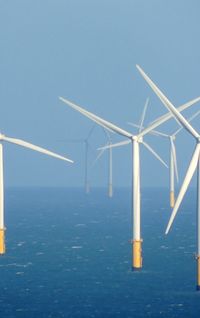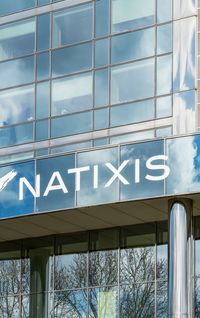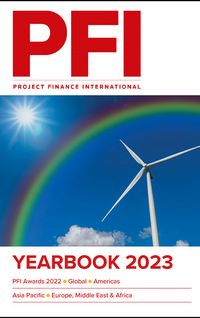Bank of the Year – MUFG
MUFG had a stellar year in project finance across the globe in all areas of the market’s activity. It currently tops the loan league tables and is third in the bond tables. It has closed a remarkable 187 deals thus far this year via 300 project finance professionals across the globe with offices in Los Angeles, New York, London, Paris, Frankfurt, Singapore, Hong Kong, Tokyo, Sydney and Melbourne. The bank offers lending, advisory, bonds, hedging, modelling, agency and portfolio management.
In the Americas, MUFG led the way on several of the year’s largest and most innovative transactions, from renewable energy to public-private partnerships. The bank served as a lead on the financing for the Champlain Hudson Power Express (CHPE), a transmission project that will bring 1.2GW of hydropower from Canada to New York City, and the Terminal One project at New York’s JFK International Airport, both of which required perseverance, flexibility, and adaptation to rapidly changing conditions amid pandemic recovery and financing market limitations.
The bank served as a lead on other key deals including US$1.9bn in debt and tax equity financing for Primergy Solar’s Gemini solar and storage project in Clark County, Nevada that will provide 690MW of solar and 390MW of storage; a dual-tranche US$278m commercial bank loan for Sacyr-backed concessionaire Union del Sur’s Pasto–Rumichaca 4G roadway public-private partnership in Colombia; and Venture Global’s US$13.2bn project financing for the Plaquemines LNG facility and Gator Express pipeline in Louisiana.
MUFG did some notable work in Latin America. On the loan side, the bank was on some of the more impressive financings done in the region, including on Sacyr’s multi-currency, multi-tranche US$800m deal for the Pasto–Rumichaca 4G roadway PPP in Colombia, the US$700m acquisition loan done by EIG and Fluxys backing the purchase of the GNL Quintero LNG terminal in Chile, and the US$139.9m financing of Transmisora Colombiana de Energia’s 500kV La Virginia to Nueva Esperanza transmission line and expansion of the associated substations in Colombia, among a raft of others.
The bank acted as one of the first movers in Latin America in the offshore wind market when it helped Engie and EDP Renovaveis' offshore wind joint venture Ocean Winds land a €325m bond backing its 15.2GW offshore wind pipeline in waters off Brazil. It also worked with newly-formed Sempra Infrastructure Partners to close that group’s inaugural bond issue, selling US$400m in senior unsecured 10-year 144A/Reg S notes backing its operations in the region.
In Asia-Pacific, as of end of November this year the bank ranked as the third busiest lender with 27 signed transactions having a value of US$3.3bn. And in Australia, MUFG was present among the massive transactions completed this year, such as the US$3.66bn Ichthys LNG deal, the US$3.5bn loan for GIP Sharon Finco, the US$3.2bn Sydney Airport deal, and the US$2.3bn Victoria roads privatisation project. In India, MUFG was an arranger in the RTC renewable energy project of Renew Surya, and was involved in a rare US$761m loan for Guam Ukudu Power and the innovative Ishikari offshore wind and battery storage project.
MUFG has expanded its activity in the renewable energy markets in Southern Europe with a strong pipeline of deals in the region. Spain is currently the second-largest generator of renewable power in Europe and the bank’s ambition is to become one of the top financial institutions in the renewable energy project finance space in the region. Deals transacted include underwriting the €2.3bn Finerge portfolio and new capex facility on the Iberia peninsular and the €226m Elawan financing in Spain.
In the Gulf, MUFG advised on one of the most innovative deals of the year – the US$3.6bn Lightning scheme that will connect ADNOC's offshore oil production facilities to ADPower’s onshore electricity grid. The Kepco/Kyushu Electric Power/EdF team won the project, which will allow ADNOC to decommission aging on-platform gas turbine generators while accessing low carbon electricity from EWEC’s nuclear and solar sources.
The bank has a regionalised structure with no overall global project finance head. In the Americas, the team is led by Erik Codrington, in Asia by Shivanan Sivarajah with Rob Ward head in Australia, and in EMEA, Philip Hall. Former project finance heads in New York and London keep an eye on things as Americas and EMEA heads of global corporate and investment banking respectively, Jon Lindenberg and Phil Roberts.
Bond House of the Year – SMBC
SMBC was the most impressive player in the project bond market this year, expanding its activities, leading some marquee transactions and closing deals across a range of sectors and geographies. From Saudi Arabia to Santiago, the group’s ability to provide a range of services, from leading transactions to advising on ratings, meant it stood out from the crowd in 2022.
The Tokyo-based behemoth has rapidly expanded its debt capital markets capabilities over the last few years, with operations in New York, London, and several countries in Asia. It has used its solid project finance operation as a base to expand its private and public project bond offerings, with a team capable of structuring, rating and executing deals.
The group was involved in some of the nameplate transactions done globally – particularly in the US private placement (USPP) market, which is growing rapidly and thirsty for exposure to ESG-related offerings and the higher returns available in infrastructure financing, particularly in emerging markets.
SMBC was the key part of the US$710m green bond private placement done for Canadian company Innergex Renewable Energy’s purchase and refinancing of its renewable energy portfolio in Chile, one of the deals of the year. The deal showcased the bank’s ability to serve as a one-stop shop for its clients.
In the deal, the bank was financial adviser to the sponsor and complemented that by serving as sole lead placement agent on the USPP, a 14.4-year note issue priced at 6.28%, or the ICUR plus 330bp. The bank’s mandate also included a ratings advisory component, showing how it was able to plug any number of holes on behalf of its clients.
In other notable deals, SMBC was the joint lead placement agent on the Wink to Webster US$535m USPP, a pipeline for intrastate crude oil transportation in Texas, the largest 4(a)(2) oil pipeline deal since 2018, with US$2bn in bids, driving levels below price talk. It was also part of the £200m USPP for Heathrow Airport, when SMBC employed a targeted marketing approach that enabled Heathrow to welcome two sizeable new accounts to its existing group of investors.
SMBC was active in public markets. With a growing presence in the US municipal space, it was a joint lead manager for the noteworthy US$1.354bn JFK New Terminal One airport financing. The bank was active in non-project deals for major players in the market such as Avangrid and SHV Nederland, which reflected positively on the bank in the award.
SMBC this year priced a landmark transaction of US$701m in senior secured green bonds for Sweihan PV Power Company, the largest single site solar PV project in the world with capacity of 1,177MW and the first renewable project in the Gulf region to be financed in the bond market. The Baa1/BBB+ rated 27-year Sweihan solar project bond issue was priced at 3.625%, below its initial guidance of 3.875%, with an order book of US$1.6bn.
SMBC led the whopping debut US$2.5bn financing for EIG Pearl Holdings’ Saudi Aramco oil pipeline acquisition – an inaugural bond offering and the first major project bond from the Kingdom of Saudi Arabia priced in quick time early in the year in the face of inflation concerns and a choppy market. It also priced a £300m senior secured green bond issue for Bazalgette Finance, an SPV set up to construct and operate the Thames Tideway Tunnel running underneath the Thames in London.
SMBC Group has more than 450 professionals working on project finance across the globe. The group’s operating companies active in the project bond space include SMBC, SMBC Nikko Securities America, and SMBC Capital Markets, among others. Anthony Ruffino looks after project bonds for North America, Wilfried Marchand for Latin America and Fabrizio Baicchi for EMEA.
Adviser of the Year – Credit Agricole
Credit Agricole has closed some of the biggest deals in the project finance market this year across a range of sectors. Advisory business models have always been caught between two objectives, bringing in fee income and serving clients, particularly important clients. Credit Agricole manages the two objectives by having a specialised advisory pool backed up by all members of its project finance team.
The team had successes in offshore wind, fibre and transport. In the offshore wind sector its standout deal was advising Orsted on the sell-down of a 50% stake in the 1.3GW Hornsea 2 project off the UK, the Global M&A Deal of the Year. As it was, the stake was sold to Credit Agricole Assurance and AXA IMI Alts but the competition was said to be fierce with a £3bn sales price achieved. Unlike on many M&A deals, the winner used the £2bn stapled financing put together by Credit Agricole.
In addition, later in the year it raised a £400m private placement to back Eni-Plenitude and Hitec Vision’s 20% stake in the Dogger Bank offshore wind farm currently under construction. It advised on one of the French floating offshore wind project financings, the 30MW, €300m Leucate deal for Ocean Winds. And advised Ocean Winds on its £2.4bn, 882MW Moray West UK offshore wind financing, one of the large project financings in the autumn. The deal is backed by a contract for difference and major corporate power purchase agreements (PPAs) with Amazon and Google – making it a step that moves the offshore wind sector further along.
In the telecoms and fibre sector, the bank advised on one of the largest deals thus far, for Deutsche Glasfaser Group (DGF), a €5.75bn financing that closed at the start of the year and is the Europe Telecoms Deal of the Year. DGF is the largest independent fibre operator is Germany and plans to cover 4m homes by the end of 2025. It is owned by EQT Infrastructure and OMERS. In addition, Credit Agricole was M&A and financial adviser to Vauban on SDFast, a new joint venture between Vauban and Bouygues Telecom, which will acquire long-term access rights to fibre lines from infrastructure operators, and then rent them to Bouygues as an anchor tenant. The bank raised a 20 year, €1.6bn debt package to go with the new joint venture.
In the rail sector the bank advised on a range of debt and M&A deals. It placed US$300m and €460m of debt in a private placement for railcar and tank container company Ermewa to refinance capex. It raised €200m in notes and €348m for rolling stock lessor Alpha Trains, and €500m in a private placement and €550m in a bank loan for rail lessor Railpool. It also advised Globalvia on selling a 24% stake in ILSA, and RGCX on selling a large rail car fleet.
In infrastructure, Credit Agricole advised Equitix on buying into the UK AirTanker PFI deal and Meridiam on buying a 40% stake in New Suez.
The energy and infrastructure group is headed from Paris by Jean Francois Grandchamp with Matthew Norman having been appointed head of advisory this year as project financier Danielle Baron moved up to become global head of structured finance. Andy Pheasant leads the London advisory team and resources and industry. Quentin Slight leads the power and utilities advisory team and Elodie Moreau leads telecoms, while Jerry Vincitore heads the team in New York and Jose Gonzales de Canales in Madrid.
Sponsor of the year – Quinbrook
London-headquartered Quinbrook Infrastructure Partners, the ESG-focused specialist investor and asset manager, has been involved in some of the largest developments in its focus area across three key markets: the US, the UK and Australia. It is PFI’s Sponsor of the Year.
Founded by David Scaysbrook and Rory Quinlan, Quinbrook’s investment teams and portfolio companies have invested more than US$2.5bn of equity in over 200 low carbon, renewable, storage and grid support projects covering a wide spectrum of technologies.
In March, Quinbrook portfolio company Primergy Solar, which focuses on solar and energy storage, chose the contractors – Kiewit Power Constructors, EPC contractor, and IHI Terrasun Solutions, battery storage integrator – for its US$1.2bn Gemini 690MW/966MW DC solar and 1,416MWh battery storage project near Las Vegas.
Gemini combines the dual goals of sustainable renewables development and ESG impact across job creation, environmental stewardship, emissions, and local community engagement.
The sponsors were able to attract strong support from the project’s offtake customer, local utility NV Energy. Quinbrook secured a sales contract of more than US$2bn with NV Energy, part of Berkshire Hathaway Energy, which will buy 100% of the power output under a 25-year power purchase agreement (PPA). The PPA is structured to store solar power during the day and discharge it in the 4pm to 9pm period across the "super peak" summer months of June to August.
With the PPA in place, it was able to attract a high calibre syndicate of lending banks to fund the scheme. In April, Quinbrook and Primergy closed the US$1.9bn project debt and tax equity financings for Gemini.
The landmark financing included a construction term loan, tax equity and equity bridge loans, and a letter of credit facility totalling US$1.3bn. There were over US$500m in tax equity commitments. Debt facilities were arranged by four coordinating leads: KeyBanc Capital Markets, MUFG, Bank of America, and Nord/LB. The tax equity investment, thought to be the largest single-asset tax equity financing for a US solar project, was provided by Bank of America and Truist Bank. Truist advised Quinbrook and Primergy on the transaction.
In October, Quinbrook and Primergy sold a 49% equity stake in Gemini to APG, the largest pension asset manager in the Netherlands, on behalf of pension fund ABP. Primergy has since moved on to begin the permitting process on the Hesperus 155MW solar and 155MW battery storage project in La Plata County, Colorado.
Elsewhere in the US, Quinbrook sold Scout Clean Energy to Brookfield Renewable for US$1bn in cash. Scout had earlier sold the 199MW Persimmon Creek wind farm in Oklahoma, developed alongside Spain’s Elawan Energy – Scout held 75% of the JV – to investor-owned utility Evergy for US$250m.
In Australia, Quinbrook launched one of the largest permit-approved data storage campus projects in the Southern Hemisphere. The A$2.5bn (US$1.7bn) "Supernode" project will also host one of the largest battery storage installations in the Australian National Electricity Market. The project will have up to four hyperscale data centres with up to 800MW in capacity and an up to 2,000MWh battery energy storage system. The grid-connected battery will provide dispatchable supply and firming services to the National Electricity Market.
In the UK, Quinbrook is putting in place a project debt financing to back its four synchronous condenser projects in Scotland totalling £220m. The operating contracts run for 10 years and the debt will be priced at less than 200bp. The debt/equity split is circa 60/40. The cashflow from the contracts make up 90% of project revenues. Construction on the Scottish schemes is due to be completed by October 2024. Spanish contractor Ingetean has won two of the Scottish schemes.
The financing will include a smaller project at Rassau in Wales under Phase 1 of the programme. In February, Quinbrook completed construction and commissioning of the new synchronous condenser installation.
The schemes will replace spinning systems used in former coal and nuclear plants to stabilise the grid, given that transmission system short circuit levels (SCLs) are falling and renewable generation is increasing. Quinbrook and its partner Welsh Power have won a further two projects in Phase 3 for schemes in England and Wales totalling £192m and these could add to the eventual funding package.
Investor of the Year – Actis
London-based sustainable infrastructure investor Actis had a momentous year realising investments from its energy funds, making a series of planned exits around the world. It has added assets to its long-term infrastructure fund. Actis executed at scale. It is PFI’s investor of the year. Actis splits its infrastructure franchise across two strategies. The Energy Fund team follows a private equity strategy, looking to exit investments once commercial operation has been reached, while the Long Life Infrastructure team looks for long-term operating returns
The teams number close to 40 members and are led from London by head of energy infrastructure and head of Actis Energy Fund 5 (AE5) Lucy Heintz. Actis’ Long Life Infrastructure team invests in operating assets, looking to develop and return long-term yield to its limited partners. Adrian Mucalov in Singapore heads the team. Actis recently extended its footprint in Asia by opening an office in Tokyo. It expects to commit almost US$500m in Japan over the next five years.
Actis Energy’s latest fund, AE5, closed in 2021 with US$6bn of investable capital, and this year it secured a novel US$1.2bn impact-linked revolving subscription credit facility that comes with a margin adjustment mechanism triggered by funds meeting one or more of three criteria: investment in energy assets that mitigate climate change; investment in a country where energy access is limiting economic growth; and creating a "new positive impact".
Energy exits included the sale of Atlas Renewable Energy, the second largest independent renewables developer in Latin America, to Global Infrastructure Partners (GIP) in a deal worth almost US$2bn. Atlas was founded in 2016 with the support of Actis.
Actis also sold its renewables platform in Brazil, Echoenergia, to Equatorial Energia. Equatorial bought Echoenergia from the Actis affiliated Brazilian fund Ipiranga Fundo de Investimento em Participacoes Multistrategia. Actis established Echoenergia in 2017.
Echoenergia’s sale represented the third major energy exit in Latin America over 12 months following the sale of Mexico-based independent power producer (IPP) Saavi Energia to GIP in 2021 and the February 2022 exit from Aela Energía.
Actis and Mainstream Renewable Power realised their investment in Aela Energía, the largest renewable energy IPP in Chile, with a sale to Canadian- developer Innergex Renewable Energy for US$686m, including the assumption of US$386m in non-recourse debt.
In Africa, Actis and Mainstream also sold the Lekela platform to Infinity Group and Africa Finance Corporation (AFC) for an enterprise value of US$1.5bn. Established in 2015, Lekela is the continent’s largest pure-play renewable energy IPP. An exit is close in India, with Shell Overseas Investments agreeing to buy renewables platform Solenergi Power for US$1.55bn, and with it renewable energy supply company Sprng Energy.
In terms of acquisitions, AE5 took a controlling stake in Yellow Door Energy. Dubai-based YDE is the leading distributed commercial and industrial solar platform in the Middle East and Africa.
In July, AE5 made its first acquisition in the Americas, taking a stake in Omega Energia, the largest publicly listed pure renewable energy generation company in Latin America. Actis will provide fresh equity capital as well as sector expertise to establish Omega as a leader in energy transition across the Americas. In June, AE5 launched Bridgin Power, a power generation business pursuing gas-fired power projects and an equitable energy transition in South-East Asia. Bridgin Power targets a total portfolio capacity of 1.2GW across the region by 2028.
Bridgin recently acquired 49% of a 220MW combined-cycle gas turbine power plant in Bhola, Bangladesh, from India’s Shapoorji Pallonji group.
Actis’ Long Life Infrastructure Fund has made its first investment in Indian roads, buying six operating toll road projects from Welspun Enterprises for an aggregate enterprise value of US$775m.
The fund, which closed in 2019 with US$1.23bn raised and up to US$2bn including co-investment mandates, targets operating assets in Latin America, Africa and Asia. It has also looked to Eastern Europe, the Middle East and Turkey in 2022. In March, it acquired Uluğ Energy Distribution and Retail Services from Limak Group. Uluğ serves the South Marmara Region of Turkey. In April, it acquired a stake in Emirates District Cooling Company (Emicool) from Dubai Investments, forming a 50/50 JV to support Emicool becoming one of the leading providers of sustainable district cooling services in MENA.
Law Firm of the Year – Allen & Overy
Since deepening its bench in the US last year, Allen & Overy can claim that it is the only firm to lead the energy and infrastructure legal market across EMEA, APAC and the Americas. Allen & Overy is PFI’s Law Firm of the Year.
A spread of deals across all regions is a major differentiator that sets the Allen & Overy team apart. In the annual LSEG/Refinitiv PFI legal survey for 2021/22, Allen & Overy occupied the top spot on the league table with 44 deals closed, split almost evenly between the sponsor side, 23, and lenders, 21. It was also consistent across regions.
The projects, energy and infrastructure (Penri) team, led by David Lee, has members working on greenfield developments and financings across a range of transactions for governments, sponsors and lenders/bond arrangers. It is equally active working on capital recycling through M&A transactions, refinancings and restructurings.
The energy team is headed by Troy Edwards, Marie Stoyanov, and John Marciano; infrastructure by Richard Evans and Kent Rowey; and projects by Ian Ingram-Johnson and Tim Scales. The group has built relationships with new market entrants in hydrogen, CCS, batteries and green steel, while growing its long-standing clients.
In Europe, despite deal volumes dropping year on year, Allen & Overy continued to see a mix of business.
In energy, it counts Hornsea Two, the Gemini OSW financing amendment, the Wikinger OSW, Grabowo, EDP wind farm portfolio and the Akuo onshore wind farm in its Renewables activity. In Power, deals included a giga-scale hydrogen and green steel project in Europe, a lithium-ion battery giga-factory in Sweden, and the development and financing of a first-of-a-kind blue hydrogen production facility in the UK.
It acted on GD Towers, the Eurofibre refinancing, the Wallonia FTTH Network, Phoenix Towers and the Rosace Network Refinancing. Allen & Overy advised on Sémop Port La Nouvelle and the DCT Gdansk Container Terminal and its roads business included the A3 in Italy and the A69 in France. It was on the Alpha Trains refinancing and Eurotunnel, and transactions for Zenobe Electric Vehicles and InstaVolt.
The emerging markets team advised on a mix of deals across the energy sub-sector, including two hydropower projects, Kinguele Aval in Gabon and Upper Nyamwamba in Uganda. Other deals included Koudia El Baida in Morocco, Zina Solaire in Burkina Faso and the Gafsa and Jorf Lasfar power plants in Tunisia and Morocco, respectively.
Mining projects included Kipushi Tailings in the Democratic Republic of Congo and ongoing work on the Tri-K Gold Mine in Guinea. Infrastructure mandates include Damietta Port in Egypt, and Kigali Innovation City in Rwanda. In oil and gas, a cross-jurisdictional team is advising on the East Africa Crude Oil Pipeline between Uganda and Tanzania.
In the Americas, Allen & Overy advises on deals from creation to acquisition: equity and debt capital-raising, restructuring and portfolio management, as well as asset sales, arbitration and litigation, and construction projects.
Closed deals for 2022 include the Apollo portfolio, two wind transactions for InfraRed, and Gemini Solar + Storage in renewables; the largest PPP project in the US, the financing of JFK’s New Terminal One; the DFC investment in Fulbright University; and the Rumichaca-Pasto 4G Toll-road.
In Asia, it advised on Engie’s divestment of Indonesia geothermal assets. It was involved in the Patimban New International Port, the first in Indonesia’s seaport sector, and the financing of a 60MW solar power project in Cambodia.
Allen & Overy also advised on the refinancing of the Nusantara-1 satellite project, providing a flexible structure to reflect the diminishing risk profile.
In the Middle East, it advised on all the big-ticket deals in the region, including one of the largest energy infrastructure deals in the world and the largest energy infrastructure deal in the region – the US$15.5bn natural gas pipeline in Saudi Arabia. It also advised on the Zayed City Schools PPP, the first school infrastructure PPP in the UAE; the first limited recourse data centre financing for Tamsuk in Saudi Arabia; on a US$5bn investment in three of DP World’s flagship UAE assets; and on the US$1.1bn refinancing of the 1.6GW Mirfa IWPP in the UAE.
ESG Deal of the Year – AMEA Power
In the year of the COP27 conference in Egypt, one developer actually turned all the discussions into real, funded projects the week after the conference had finished. Dubai-based developer AMEA Power, headed by owner and chairman Hussain Al Nowais, reached closed on two 500MW schemes, one for wind at Ras Ghareb and one for solar at Kom Ombo, on the same day.
Given the current climate of rising equipment and construction prices, getting these two deals over the line at pre-agreed tariffs was an achievement, with the wind deal coming in at US$0.03/kWh and the solar deal at US$0.02/kWh. To improve the economics, the power purchase agreements (PPAs) were lengthened to 25 years and the tip heights on the turbines increased, but apart from that the deals had to stand or fall. Bringing in Chinese contractors helped, replacing previously selected Western suppliers.
The deals are important for a wider project finance market reason. On the wind scheme, the World Bank/IFC and Japan’s JBIC are working together for the first time. Given the global transition funding requirements, having the two on the same deals will be vital going forward. The two fell out in 2014 on the Star Refinery deal in Turkey over the World Bank/IFC's insistence on preferred creditor status (PCS). On Ras Ghareb a mechanism has been agreed whereby the IFC keeps its PCS. It will be able to take dollars out of the project first in the event of problems while there will be mechanisms for the other DFIs to catch up later and have secured local escrow accounts.
AMEA Power and Sumitomo are jointly developing the US$709m 500MW wind scheme at Ras Ghareb while AMEA Power is developing the US$400m 500MW solar scheme in Kom Ombo, Aswan. Sumitomo Mitsui Trust Bank will provide the EBL to Sumitomo on the wind deal and GIB will provide the EBL to AMEA. The debt financings will run for construction plus 18.5 years, meaning 20 years for solar and 21 years for wind.
On the wind scheme debt, JBIC is providing US$294m and IFC US$50m. SMBC, Standard Chartered and SMTB are providing US$95m, US$50m and US$50m, respectively under Nexi cover. CIB is the working capital account bank and IFC and SMBC are providing US$440m and US$100m, respectively, on the hedging. On the solar scheme IFC and JICA are providing US$95m each and FMO is providing US$65m. IFC is the hedging bank and Citigroup is the agent.
Clifford Chance and Baker McKenzie advised the sponsors. Milbank and Shalakany advised the lenders on the wind deal and Norton Rose Fulbright and Shakary & Shehan advised the lenders on the solar deal.
PowerChina and HDEC Middle East will be the EPC contractors on the AMEA wind scheme and Envision will supply the turbines. Construction is expected to begin in March with operations starting 2-1/2 years later.
AMEA Power was established as the power project development arm of Al Nowais Investments. It has not chased all the deals in the Middle East and Africa but has adopted a more selective approach in countries such as Egypt. David Falcon joined the developer as CFO from Edmond de Rothschild this year. Mohamed Al Nowais is the managing director. Hussain Al Nowais is the chairman and Dirk Beeuwsaert, formerly of Tractebel, Suez and Engie, is the vice-chairman.
M&A Deal of the Year – Hornsea 2
The £3bn Hornsea 2 deal is the largest single project M&A deal in the offshore wind sector thus far. Plenty more of these will be needed if the sector is to grow at the pace expected of it. Developers are available to build these projects, the construction chains are growing, albeit with challenges, and investors are keen on renewable assets. Marrying the three together, as on Hornsea 2, is vital.
Orsted developed the farm-down model but then, for a time, was looking to keep hold of its assets. Given the size of the projects, it is now back in farm-down mode. That said, it took the 1.3GW Hornsea 2 scheme all the way into full operations, achieved in August 2022, before selling a 50% stake to AXA IMI Alts and Credit Agricole Assurances in September for £3bn.
Just as the deal was closing, the UK was hit by extreme turbulence in the capital markets due to the mini budget and the developer and the advisers had to respond with certain workarounds in order to get to financial close.
Orsted has kept 50% and will run the 20-year operations and maintenance from its P&M base at the Port of Grimsby, the largest base for offshore wind farms in the world. Hornsea 2 is itself currently the largest offshore wind farm in the world.
AXA IMI Alts and Credit Agricole Assurances emerged as the winner of the deal in the spring and utilised a stapled financing put in place by the financial adviser on the deal, Credit Agricole CIB. Stapled financings have rarely been used in M&A deals and act as backstops, but on this occasion it was taken up. With credit conditions changing and these types of deals getting bigger, maybe there will be more use of staples.
The 17-year £2bn senior debt financing was a holdco deal and with the spread coming in around the 150bp mark was attractively priced for the sponsor. The deal included an export credit agency (ECA) tranche from Danish ECA EKF. At 30 banks, the deal has the largest number of banks in an offshore wind deal. The financing is backed by a contract for difference (CfD) at £57.5/MWh.
Orsted was advised on the deal by Linklaters, while the banks were advised by Allen & Overy. Riskbridge advised Orsted on hedging.
The banks are AIB, ARS-Levensverzekezing, Bank of America, Bank of China, Barclays, BNP Paribas, BNP Paribas Fortis, CIBC, CIC, DZ, Helaba, HSBC, ING, LBBW, KDB, Lloyds, Mitsubishi Trust, MUFG, Mizuho, Natixis, NatWest, Norinchukin, OCBC, SEB, Siemens Bank, Societe Generale, Standard Chartered, SMBC. Sumitomo Mitsui Trust and UniCredit.
This was the first financing in which Orsted applied its farm-down model to an operational asset in the UK. Lenders could accept a more simplified debt arrangement akin to the dividend holdco financings seen in the sector, rather than something indirectly analogous to a project level financing.
There was a simplified security structure rather than a multi-layered security and intercreditor agreement. There was only one direct agreement in the deal with no third-party direct agreements. These changes should make farm-down deals in the sector easier going forward. In addition the funding banks were not given the right to take part in the hedging but had to compete.
To see the digital version of this report, please click here
To purchase printed copies or a PDF of this report, please email leonie.welss@lseg.com
















